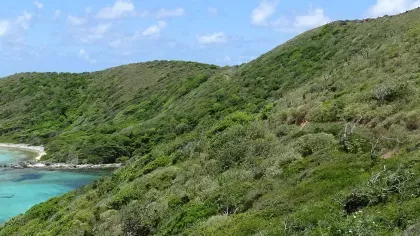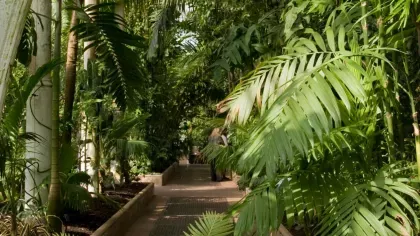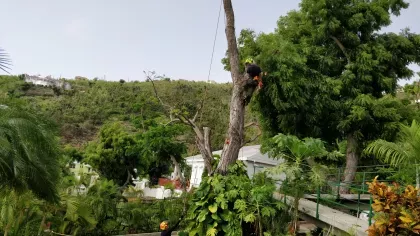Tropical Important Plant Areas (TIPAs) in the British Virgin Islands (BVI)
Identifying key sites for plant and habitat conservation in the British Virgin Islands (BVI).

British Virgin Islands and the Puerto Rican Bank Floristic Province
The British Virgin Islands (BVI), one of the UK Overseas Territories (UKOTs), is situated 96 km east of Puerto Rico in the Caribbean Islands Biodiversity Hotspot. The main islands are Tortola, Virgin Gorda, Anegada and Jost Van Dyke, together with over fifty smaller islands and cays comprising a land area of only 153 km2. The landscape varies from steep-sided hills of volcanic origin arising from the sea on the largest island, Tortola, to the flat coral limestone island of Anegada which reaches a maximum of 8 m above sea level. Many different habitat types are found in BVI, five of them being nationally threatened: coastal shrubland, upland evergreen forest, semi-deciduous gallery forest, mangroves and dry salt flats.
Botanically, the BVI are part of the Puerto Rican Bank Floristic Province which also includes the US Virgin Islands and Puerto Rico. Based on the Smithsonian Institute's Catalogue of Seed Plants of The West Indies, there are 911 plant species recorded from BVI and 71% of those are native. We know of four plant species endemic to BVI: Vachellia anegadensis, Metastelma anegadense, Pitcairnia jareckii and Senna polyphylla var. neglecta.
Identifying Tropical Important Plant Areas in BVI
Despite BVI having several legally protected areas, knowledge on the location and distribution of threatened plants and habitats is still needed to provide a framework for the protection and management of the most important sites for wild plant diversity. Important Plant Areas (IPAs) are a network of key sites for the conservation of wild plants and threatened habitats, which can provide this framework for conservation. The global criteria and methodology for identifying IPAs were published in 2004 by Plantlife International. Since then, 1,771 IPAs have been identified across 16 countries in Europe, including the UK, and several projects have been completed around the world.
In 2015, Kew and Plantlife launched a consultation on the Important Plants Areas (IPA) Criteria and a new phase of IPA identification in the Tropics (TIPAs) became one of Kew’s scientific strategic priorities. In 2017, Darbyshire et al. published the guidelines for the identification of TIPAs. The project ‘Identifying and Conserving Tropical Important Plant Areas (TIPAs) in the British Virgin Islands’ (2016-2019) was a partnership between Kew’s UKOTs team and National Parks Trust of the Virgin Islands (NPTVI), with financial support from HSBC’s 150th Fund. Consolidated data from digitized herbarium specimens and observations during field surveys on the status and locations of threatened plant species and nationally threatened habitats have been shared with partners in-territory to inform conservation efforts and management decisions. The standards and methodologies developed can be applied more broadly in other Caribbean countries in the future.
Regional and international collaboration for plant conservation
The BVI TIPAs project was an international collaboration led by Kew and NPTVI with regional partners from the University of Puerto Rico Mayaguez Campus Herbarium (MAPR), Caribbean Ecological Services Field Office of the US Fish and Wildlife Service (USFWS) and the Puerto Rico Departmento de Recursos Naturales y Ambientales (DRNA). These collaborations have not only contributed to the project’s outputs but also created opportunities for plant conservation efforts on a regional scale through networking and information sharing.
- Network of 18 TIPAs across the BVI archipelago identified, mapped and uploaded into Kew’s online portal Tropical Important Plant Areas Explorer.
- Interactive map of the BVI TIPAs Network produced and available open access online.
- BVI TIPAs guide on BVI's threatened plant species, threatened habitats, invasive plant species and TIPAs based on field surveys and literature published and available open access online.
- BVI TIPAs interpretation panels produced and installed at several sites across the BVI and made available electronically.
- BVI TIPAs Final Technical Report published and available open access online.
- Extinction risk assessments of 20 endemic and near-endemic BVI plants completed and published on the IUCN Red List of Threatened Species.
- Data for 35 BVI priority species from digitised vouchers, existing observations and new botanical surveys incorporated into Kew’s UKOTs Species and Specimens Database.
- Spatial data on BVI priority species and habitats added to customised Geographic Information System (GIS), shared with NPTVI and added to BVI’s National GIS.
- UKOTs Online Herbarium
- A set of interpretation panels were produced that feature the BVI TIPAs and the important plants and habitats they contain. The set also contains a panel describing the work by Kew and NPTVI to conserve the native plants of the BVI in ex-situ collections. The interpretation panels can be downloaded and are also on display at several sites across the BVI, including the JR O’Neal Botanic Gardens on Tortola.
- The BVI TIPAs National team produced a guide entitled ‘Retaining Nature’s Little Secrets - A Guide to the Important Plants and Tropical Important Plant Areas of the British Virgin Islands’ that highlights the BVI’s 18 TIPAs and contains details of 53 of the BVI’s most important plants, including threatened species and the most serious invasive species.
- The final technical report produced by the BVI TIPAs national team is a comprehensive document which contains the methodology used to identify the BVI TIPAs network, biodiversity summaries for each TIPA, main project outputs and links to field reports and publications. The report should be cited as: Dani Sanchez, M., Clubbe, C. and Hamilton, M. A. (eds.) (2019). Identifying and Conserving Tropical Important Plant Areas in the British Virgin Islands (2016-2019): Final Technical Report. Richmond, Surrey, UK: Royal Botanic Gardens, Kew. DOI: 10.13140/RG.2.2.13716.45441
British Virgin Islands
- National Parks Trust of the Virgin Islands (NPTVI). Follow NPTVI on Facebook.
- Ministry of Natural Resources, Labour and Immigration
Puerto Rico
- Herbarium of the University of Puerto Rico Mayagüez Campus (MAPR)
- Puerto Rico Departmento de Recursos Naturales y Ambientales (DRNA)
USA
-
Caribbean Ecological Services Field Office, US Fish and Wildlife Service (USFWS)
International
HSBC 150th Anniversary Fund
Wikipedia
Kew Strategic Output
Tropical Important Plant Areas


